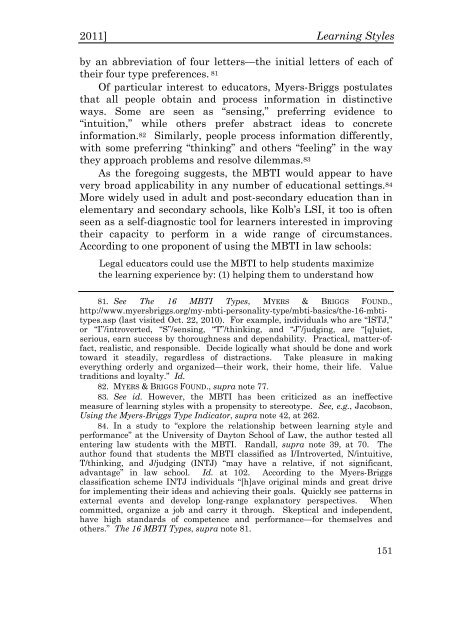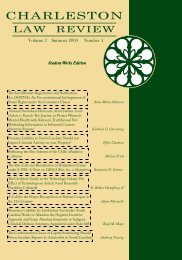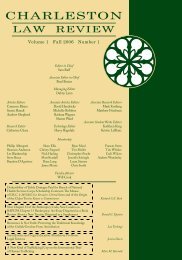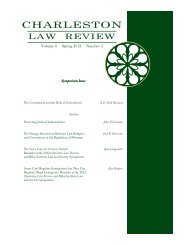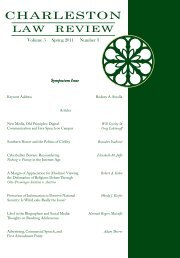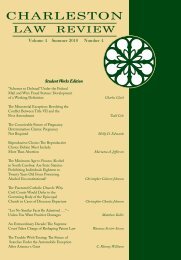Volume 5 Winter 2011 Number 2 - Charleston Law Review
Volume 5 Winter 2011 Number 2 - Charleston Law Review
Volume 5 Winter 2011 Number 2 - Charleston Law Review
Create successful ePaper yourself
Turn your PDF publications into a flip-book with our unique Google optimized e-Paper software.
<strong>2011</strong>] Learning Stylesby an abbreviation of four letters—the initial letters of each oftheir four type preferences. 81Of particular interest to educators, Myers-Briggs postulatesthat all people obtain and process information in distinctiveways. Some are seen as “sensing,” preferring evidence to“intuition,” while others prefer abstract ideas to concreteinformation. 82 Similarly, people process information differently,with some preferring “thinking” and others “feeling” in the waythey approach problems and resolve dilemmas. 83As the foregoing suggests, the MBTI would appear to havevery broad applicability in any number of educational settings. 84More widely used in adult and post-secondary education than inelementary and secondary schools, like Kolb’s LSI, it too is oftenseen as a self-diagnostic tool for learners interested in improvingtheir capacity to perform in a wide range of circumstances.According to one proponent of using the MBTI in law schools:Legal educators could use the MBTI to help students maximizethe learning experience by: (1) helping them to understand how81. See The 16 MBTI Types, MYERS & BRIGGS FOUND.,http://www.myersbriggs.org/my-mbti-personality-type/mbti-basics/the-16-mbtitypes.asp(last visited Oct. 22, 2010). For example, individuals who are “ISTJ,”or “I”/introverted, “S”/sensing, “T”/thinking, and “J”/judging, are “[q]uiet,serious, earn success by thoroughness and dependability. Practical, matter-offact,realistic, and responsible. Decide logically what should be done and worktoward it steadily, regardless of distractions. Take pleasure in makingeverything orderly and organized—their work, their home, their life. Valuetraditions and loyalty.” Id.82. MYERS &BRIGGS FOUND., supra note 77.83. See id. However, the MBTI has been criticized as an ineffectivemeasure of learning styles with a propensity to stereotype. See, e.g., Jacobson,Using the Myers-Briggs Type Indicator, supra note 42, at 262.84. In a study to “explore the relationship between learning style andperformance” at the University of Dayton School of <strong>Law</strong>, the author tested allentering law students with the MBTI. Randall, supra note 39, at 70. Theauthor found that students the MBTI classified as I/Introverted, N/intuitive,T/thinking, and J/judging (INTJ) “may have a relative, if not significant,advantage” in law school. Id. at 102. According to the Myers-Briggsclassification scheme INTJ individuals “[h]ave original minds and great drivefor implementing their ideas and achieving their goals. Quickly see patterns inexternal events and develop long-range explanatory perspectives. Whencommitted, organize a job and carry it through. Skeptical and independent,have high standards of competence and performance—for themselves andothers.” The 16 MBTI Types, supra note 81.151


